How to Achieve Precise size Control in Roto Moulding Process at Light Venus
 Aug 24,2024
Aug 24,2024

How to Achieve Precise size Control in Roto Moulding Process at Light Venus
Roto molding, also known as rotational molding or rotomolding, is a highly versatile plastic manufacturing process used to create both simple and complex, single-piece plastic components. Although the fundamental concept of roto molding appears straightforward—involving the pouring of material into a mold and its subsequent shaping via a machine—achieving dimensional accuracy in rotomolded products can be challenging. This is particularly true when working with intricate geometries and materials with varying properties. Every stage, from product design and mold fabrication to process optimization, is critical. Overlooking or mismanaging any of these stages can lead to defects in the final products
At Light Venus, we utilize a series of techniques to ensure the dimensional accuracy of rotomolded products throughout the roto moulding process. These includes:
1. Mold Design and Pre-production Preparation
The success of achieving precise size control in rotol moulding begins with the design of the mold. Light Venus dedicates considerable time and resources to the development of high-quality molds, ensuring uniform wall thickness and precise dimensions. The design procedure incorporates the use of computer-aided design (CAD) software to establish precise mold specifications. Furthermore, Light Venus undertakes comprehensive material selection to ensure compatibility with the roto moulding process, taking into account factors such as melting point, thermal expansion, and shrinkage rates.

2. Material Preparation
The type and quantity of material used in the rotol moulding process significantly influence the final size and shape of the product. At Light Venus, we meticulously choose materials that boast a uniform melt flow index and a minimal shrinkage rate. Materials with a higher melt flow index offer enhanced flowability and fillability, which in turn leads to reduced shrinkage and improved dimensional precision. It is crucial to collaborate with material suppliers to choose the correct grade and guarantee consistent material quality. Moreover, accurately weighing the material is also vital to ensure uniformity across every batch.
3. Processing Parameters
Controlling the processing parameters is vital for achieving precise size control in roto moulding. Light Venus optimizes the rotation speed, temperature, and cooling time. The rotation speed affects the melt flow and mold filling, while the temperature influences the material’s flowability and curing rate. Properly adjusting these parameters ensures consistent material flow and uniform cooling, leading to dimensional accuracy. Monitoring and controlling the temperature throughout the process using advanced temperature control systems can significantly improve size control.
4. Cooling Control
The cooling stage is equally important, as it determines the rate at which the plastic solidifies and shrinks, affecting the final dimensions of the product. Light Venus uses sophisticated temperature control systems to manage these processes accurately. For instance, engineers design special fixtures to prevent the rotomolded product from shrinkage during the cooling phase. These fixtures provide support and stability to the part as it cools. Moreover, by employing a surrounding film layer, size can be controlled with greater precision. For intricate products featuring multiple mating assembly points, the design and management of fixtures are particularly crucial to ensure seamless assembly for customers
5. Calibration and Quality Control
Regular calibration of the roto moulding machine and stringent quality control measures are crucial for achieving precise size control. At Light Venus, we implement a comprehensive quality control program that encompasses dimensional measurements, material testing, and process monitoring. By continuously monitoring and fine-tuning the process parameters, we can promptly identify and rectify any potential issues, thereby ensuring consistent and accurate product dimensions.
6. Process Optimization
Continuous process optimization is essential for maintaining precise size control over time. This involves monitoring and adjusting machine settings, reviewing operator techniques, and analyzing product data for trends that may indicate potential size variability. Our team members undergo extensive training to ensure they have a deep understanding and precise execution of critical tasks, such as edge trimming and product appearance inspection.
If you are seeking a manufacturing partner for the production of rotationally molded parts that demand dimensional precision, please do not hesitate to contact us!
 Tel: 0086-13632687993
Tel: 0086-13632687993  Email: roto@lightvenus.com
Email: roto@lightvenus.com

 Home
Home Light Venus Launched Internal Quality Training Program on Rotational Molding Process
Light Venus Launched Internal Quality Training Program on Rotational Molding Process  You May Also Like
You May Also Like



 Tel
Tel
 Email
Email
 Address
Address








